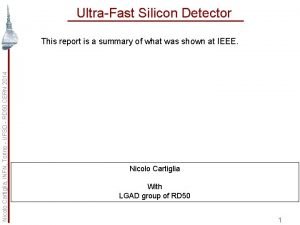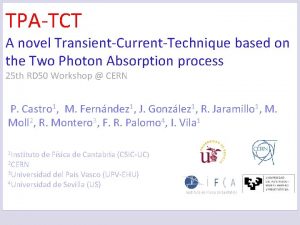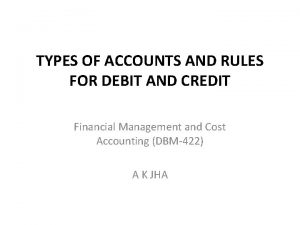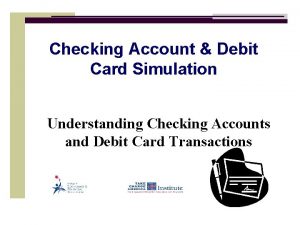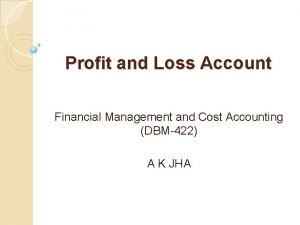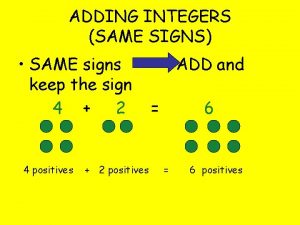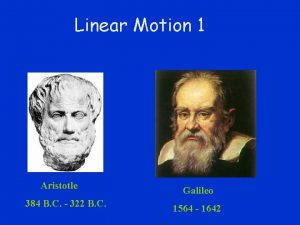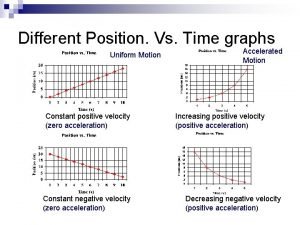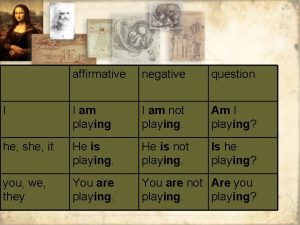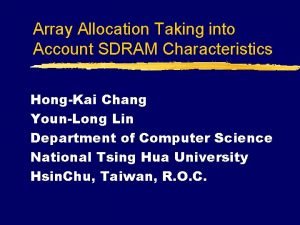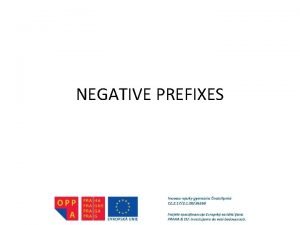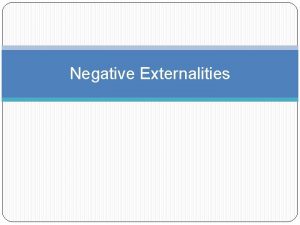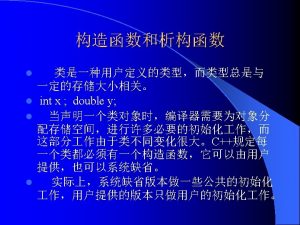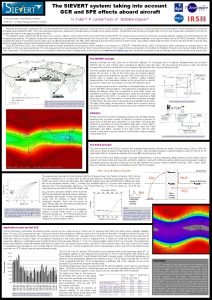Simulation of LGAD characteristics taking into account negative


















- Slides: 18

Simulation of LGAD characteristics taking into account negative feedback in Si detectors with carrier multiplication E. Verbitskaya, V. Eremin, D. Mitina, A. Shepelev Ioffe Institute St. Petersburg, Russia 27 RD 50 Collaboration Workshop CERN, Geneva, Dec 2 -4, 2015 1

Goal Our vision of the processes in LGAD: how to explain reduction of the gain and collected charge Outline PTI model of Qc enhancement in irradiated Si detectors Restriction on collected charge arisen from negative feedback in irradiated Si strip detectors Fit of the experimental data E(x) distribution in LGAD Qc vs. F dependences in LGAD and comparison with experimental data Conclusions E. Verbitskaya, , et al. , 27 RD 50 workshop, Dec 2 -4, 2015, CERN 2

Comparison between LGAD and APD Hamamatsu APD Read structures I ~ 20 p. A ( 1. 5 mm) E – hundreds k. V/cm E(x) as in heavily irradiated detector (high V) carrier avalanche multiplication but ttr = 1 ms (no trapping of nonequilibrium carriers) Internal gain G = Qam/Qo Internal gain in APD ≥ 200 Qo – induced signal without avalanche multiplication Qam - signal measured or calculated in the same detector with avalanche multiplication E. Verbitskaya, , et al. , 27 RD 50 workshop, Dec 2 -4, 2015, CERN 3

Experimental results of RD 50 Experimental data are taken in G. Pellegrini, et al. , NIM A 765 (2014) 12 and G. Kramberger, 24 RD 50 workshop, June 2014 25 ke st. nonirr. diode Gain in nonirradiated LGAD achieves 10 -20 and goes down under irradiation being higher than in standard detectors E. Verbitskaya, , et al. , 27 RD 50 workshop, Dec 2 -4, 2015, CERN 4

Model of Qc enhancement due to avalanche multiplication in irradiated n-on-p Si strip detectors The model considers: formation of Double Peak (DP) electric field profile – DP E(x); carrier impact ionization in high electric field; avalanche hole generation near the n+ contact, hole injection into the detector bulk, and hole trapping to radiation-induced deep levels defects give rise to the trapping-related negative feedback which stabilizes avalanche multiplication and total detector performance but restricts the gain Published/presented in V. Eremin, et al. , 14 and 15 RD 50 workshops, 2009, Freiburg and Geneva V. Eremin, E. Verbitskaya, A. Zabrodskii, Z. Li, J. Härkönen, NIM A 658 (2011) 145 E. Verbitskaya, V. Eremin, A. Zabrodskii, 2012, J. Instrum. , v. 7, 2, Art. No: C 02061; doi: 10. 1088/1748 -0221/7/02/C 02061 E. Verbitskaya, et al. , NIM A 730 (2013) 66 E. Verbitskaya, , et al. , 27 RD 50 workshop, Dec 2 -4, 2015, CERN 5

Negative feedback in irradiated n-on-p detectors impact ionization near n+ (e, h) hole injection hole trapping to DLs reduction of –Neff reduction of d. E/dx and stabilization of Emax at n+ reduction of ae, h Trapping-related negative feedback: stabilizes avalanche multiplication and total detector performance E(x) Emax BUT simultaneously restricts Qc enhancement p+ n+ LGAD initially contain high doped built-in layer with E ~ 10 5 V/cm DLs are introduced by radiation There is no reason to exclude the influence of negative feedback in LGAD 6 E. Verbitskaya, , et al. , 27 RD 50 workshop, Dec 2 -4, 2015, CERN

Algorithm of E(x) and Qc simulation Processes considered: formation of a steady-state E(x) distribution: equilibrium carriers (bulk generation current) and avalanche generated carriers near n+ contact, their trapping on radiation-induced DL defects; charge collection in the detector bulk with a calculated E(x) profile; e and h are generated by MIPs Procedure and main parameters ♦ numerical calculation – EXCEL MS Office ♦ Poisson equation combined with the rate equation ♦ one-dimensional approach for detector geometry ♦ Effective deep levels: DA Ec – 0. 53 e. V; ♦ 1/te, h = be, h. Feq; DD Ev + 0. 48 e. V be = 3. 2 x 10 -16 cm 2 ns-1, bh = 3. 5 x 10 -16 cm 2 ns-1 ♦ ionization rates ae, h = Ae, hexp(-Be, h/E) see also talk of V. Eremin E. Verbitskaya, , et al. , 27 RD 50 workshop, Dec 2 -4, 2015, CERN 7

Fitting of Qc(V) dependences Vmr Implantation dose 2 x 1012 cm-3 Similarity of calculated Qc(V) and experimental curves E. Verbitskaya, , et al. , 27 RD 50 workshop, Dec 2 -4, 2015, CERN 8

Electric field distribution in LGAD E(x) distribution is a key factor for charge collection Calculation: comparison between “no injection” and regarding injection Nonirradiated diode n+ E. Verbitskaya, , et al. , 27 RD 50 workshop, Dec 2 -4, 2015, CERN 9

Electric field distribution in irradiated LGAD 1 e 14 n/cm 2 the same Emax 10

Electric field distribution in irradiated LGAD 1 e 15 n/cm 2 E 11

Evolution of electric field distribution under irradiation Injection leads to potential redistribution and formation of high electric field region near the back contact Emax-b in a built-in p+ layer goes down Scale of reduction increases with fluence: the higher is the fluence, the lower is Emax-b Emax_b drops down/disappears at high F~5 x 1015 n/cm 2 E. Verbitskaya, , et al. , 27 RD 50 workshop, Dec 2 -4, 2015, CERN 12

Hole injection current distribution Hole injection current – steady-state current of holes originated by impact ionization and drifting towards the back contact Holes are trapped on radiation-induces defects, which leads to potential redistribution and reduction of electric field in a buit-in p+ layer and current E. Verbitskaya, , et al. , 27 RD 50 workshop, Dec 2 -4, 2015, CERN 13

Mechanism of negative feedback in LGAD strip LGAD E(x) Emax 1015 neq/cm 2 Emax p+ n+ E(x) Emax n+ p+ LGAD E of >1 x 105 V/cm is initially (at F = 0) and exists even at low V At 1015 neq/cm 2 high field regions are at both sides and maximal fields are comparable avalanche at back contact, electrons flow to n+, impact ionization, and so on self-consistent process which prevents breakdown E. Verbitskaya, , et al. , 27 RD 50 workshop, Dec 2 -4, 2015, CERN 14

Collected charge vs. fluence Experiment for three different LGAD Agreement is reasonable: better for W 8 Other options are available in the calculations program E. Verbitskaya, , et al. , 27 RD 50 workshop, Dec 2 -4, 2015, CERN 15

Conclusions 1. The factors which affect reduction of the gain in irradiated LGAD: Reduction of carrier trapping time constants, Trapping-related negative feedback which leads to: - redistribution of potential in LGAD bulk, - formation of high electric field region near the back contact - reduction of E in a built-in p+ layer. 2. E near the back contact stays sufficient for impact ionization, which increases collected charge with respect to standard diodes. 3. However, this effect can only partially compensate reduction of the field in a built-in layer The gain in LGAD is also restricted by negative feedback. E. Verbitskaya, , et al. , 27 RD 50 workshop, Dec 2 -4, 2015, CERN 16

Acknowledgments This work was made within the framework of CERN RD 50 collaboration and supported in part by: • Fundamental Program of Russian Academy of Sciences “High energy physics and neutrino astrophysics” Thank you for attention! E. Verbitskaya, , et al. , 27 RD 50 workshop, Dec 2 -4, 2015, CERN 17

PTI model of Qc enhancement via avalanche multiplication and negative feedback E. Verbitskaya, , et al. , 27 RD 50 workshop, Dec 2 -4, 2015, CERN 18
 Lgad
Lgad Lgad
Lgad Real and nominal account example
Real and nominal account example 3-1 checking accounts worksheet answers
3-1 checking accounts worksheet answers Endorse here on check
Endorse here on check Checking account simulation
Checking account simulation Checking account and debit card simulation answer key
Checking account and debit card simulation answer key Parts of a check
Parts of a check Checking account simulation
Checking account simulation Statement of account
Statement of account Royalty analytical table with imaginary figures
Royalty analytical table with imaginary figures Errors affecting the trial balance
Errors affecting the trial balance Explain about profit and loss account
Explain about profit and loss account Secondhand account
Secondhand account Nancy invested 6000 in a bond
Nancy invested 6000 in a bond Same signs
Same signs Negative velocity negative acceleration
Negative velocity negative acceleration Negative velocity negative acceleration
Negative velocity negative acceleration Transform the positive sentences below into negative form
Transform the positive sentences below into negative form
